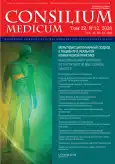Assessment of the duration of QT interval in patients with COVID-19 during treatment with hydroxychloroquine and azithromycin
- Authors: Orlov F.A.1,2, Zaitsev A.A.1,3, Kubenskii G.E.4, Pantiukhova T.N.1
-
Affiliations:
- Burdenko Main Military Clinical Hospital
- Russian Medical Academy of Continuous Professional Education
- Moscow State University of Food Production
- Clinical Hospital №1 (Volynskaya)
- Issue: Vol 22, No 12 (2020)
- Pages: 15-19
- Section: Articles
- URL: https://journals.rcsi.science/2075-1753/article/view/95347
- DOI: https://doi.org/10.26442/20751753.2020.12.200540
- ID: 95347
Cite item
Full Text
Abstract
Full Text
##article.viewOnOriginalSite##About the authors
Filipp A. Orlov
Burdenko Main Military Clinical Hospital; Russian Medical Academy of Continuous Professional Education
Email: esculap1@rambler.ru
д-р мед. наук, доц., зав. терапевтическим (консультативным) отд-нием Moscow, Russia
Andrei A. Zaitsev
Burdenko Main Military Clinical Hospital; Moscow State University of Food Productionд-р мед. наук, проф., глав. пульмонолог ФГБУ Moscow, Russia
Gleb E. Kubenskii
Clinical Hospital №1 (Volynskaya)канд. мед. наук, зав. отд-нием реанимации и интенсивной терапии Moscow, Russia
Tatiana N. Pantiukhova
Burdenko Main Military Clinical Hospitalканд. мед. наук, врач консультант-инфекционист терапевтического консультативного отд-ния Moscow, Russia
References
- Варданян Я.Т. COVID-19 и повышение риска развития желудочковых аритмий у пациентов с синдромом удлиненного интервала QT. Молодой ученый. 2020; 14 (304): 99-102. https://mo-luch.ru/archive/304/68627/
- Внезапная сердечная смерть. Рекомендации Европейского кардиологического общества. М.: Медпрактика-М, 2003.
- Сердечно-сосудистые заболевания. www.who.int;https://www.who.int/ru/news-room/fact-she-ets/detail/cardiovascular-diseases-(cvds)
- Haddad PM, Anderson IM. Antipsychotic-related QTc prolongation, torsade de pointes and sudden death. Drugs 2002; 62 (11): 1649-71.
- Myerburg RJ, Kessler KM, Castellanos A. Sudden cardiac death. Structure, function, and timedependence of risk. Circulation 1992; 85: 12-20.
- Salle P, Rey JL, Bernasconi P et al. Torsades de pointe. Aapropos of 60 cases. Ann Cardiol Angerol 1985; 34: 341-8.
- Sarganas G, Garbe Е, Klimpel А et al. Haverkamp, Epidemiology of symptomatic drug-induced long QT syndrome and torsade de pointes in Germany. Europace 2014; 16: 101-8.
- Солохин Ю.А., Макаров Л.М., Комолятова В.Н. Внезапная внегоспитальная сердечная смерть в молодом возрасте (анализ за 5 лет по данным 2-го танатологического отделения бюро Судебно-медицинской экспертизы Департамента здравоохранения г. Москвы). Мед. экспертиза и право. 2013; 4: 16-23.
- Шляхто Е.В., Арутюнов Г.П., Беленков Ю.Н., Бойцов С.А. Национальные рекомендации по определению риска и профилактике внезапной сердечной смерти (2-е изд.). М.: Медпрак-тика-М, 2018.
- Leclercq JF, Coumel P, Maison-Blanche P et al. Mechanisms determining sudden death. A cooperative study of 69 cases recorded using the Holter method. Arch Mal Coeur Vaiss 1986; 79 (7): 1024-33.
- De Luna BA, Coumel P, Leclercq JF. Ambulatory sudden cardiac death: mechanisms of production of fatal arrhythmia on the basis of data from 157 cases. Am Heart J 1989; 117: 151-9.
- Burton F, Cobbe SM. Dispersion of ventricular repolarization and refractoriness. Cardiovas Res 2001;50:10-23.
- Camm AJ, Malik M, Yap YG. Acquired long QTsyndrome. Oxford: Blackwell, 2004.
- Clinical overview of Long QT Syndrome and Torsades de Pointes. https://crediblemeds.org/health-care-providers/practical-approach/
- Darpo B. Spectrum of drugs prolonging QT interval and the incidence of torsade de pointes. Eur Heart J 2001; 3: 70-80.
- Tisdale JE. Drug-induced QTinterval prolongation and torsades de pointes. Canadian Pharmacists J/Rev Des Pharmaciens Du Canada 2016; 149 (3): 139-52.
- Остроумова О.Д. Удлинение интервала QT. РМЖ. 2001; 18: 750-4.
- Цибулькин Н.А. Синдром удлиненного интервала QT- основные клинико-патофизиологические аспекты. Практ. медицина. 2012; 5 (60): 98-103.
- Якушин С.С., Бойцов С.А., Фурменко Г.И. и др. Внезапная сердечная смерть у больных с ишемической болезнью сердца по результатам Российского многоцентрового эпидемиологического исследования заболеваемости, смертности, качества диагностики и лечения острых форм ИБС (РЕЗОНАНС). Рос. кардиол. журн. 2011; 2: 59-64.
- Dekker JM, Schouten EG, Klootwijk P et al. Association between QTinterval and coronary heart disease in middle-aged and elderly men. The Zutphen Study. Circulation 1994; 90: 779-85.
- Jackobson G, Carmel NN, Lotan D et al. Reckless administration of QTinterval-prolonging agents in elderly patients with drug-induced torsade de pointes. Z Gerontol Geriatr 2016; 51 (1): 41-7.
- Molokhia M, Pathak A, Lapeyre-Mestre M et al. Case ascertainment and estimated incidence of druginduced long-QT syndrome: study in Southwest France. Br J Clin Pharmacol 2008; 66: 386-95.
- Priori SG, Schwartz PJ, Napolitano C et al. Risk stratification in the long-QT syndrome. N Engl J Med 2003; 348 (19): 1866-74.
- Soyka LF, Wirtz C, Spangenberg RB. Clinical safety profile of sotalol in patients with arrhythmias. Am J Cardiol 1990; 65: 74A-81A.
Supplementary files






